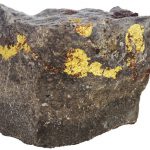 In a previous blog post, we covered the geologic processes that cause gold deposits to develop in the earth’s crust. Certain parts of the world have the geology required to support the formation of gold ores. For example, the western US has a lot of hydrothermal activity (e.g. geysers) – the area also had a large concentration of lode deposits, which spurred the California Gold Rush. When searching for new sources of gold, mining companies can reference the regional geology to decide if the area is worth exploring in more detail. By looking for certain geologic formations, miners can tell which specific areas of the region are most likely to contain gold.
In a previous blog post, we covered the geologic processes that cause gold deposits to develop in the earth’s crust. Certain parts of the world have the geology required to support the formation of gold ores. For example, the western US has a lot of hydrothermal activity (e.g. geysers) – the area also had a large concentration of lode deposits, which spurred the California Gold Rush. When searching for new sources of gold, mining companies can reference the regional geology to decide if the area is worth exploring in more detail. By looking for certain geologic formations, miners can tell which specific areas of the region are most likely to contain gold.
Productive Rock Types
Depending on the region, certain types of rock correlate with the presence of gold ore. Miners can look at the general rock types that are associated with nearby productive gold mines, and then use the presence of these rocks in other areas as potential indicators of gold.
Faults and Contact Zones
In geology, a contact zone is an area where two different rock types come together. Similarly, fault lines mark the separation of tectonic plates. Faults and contact zones form in conditions of extremely high pressure and temperatures – which could indicate the presence of intrusion-related gold deposits.
Soil Color Changes
Color changes in the soil can be an indicator of gold for several reasons. Iron is a productive rock type for gold in most regions, so large amounts of black (which indicate iron content) or red (which indicate iron oxides) could mean gold is also present. Acidic, hydrothermal fluids from lode deposits can bleach rocks to a lighter color. Soil color changes are also a sign of contact zones.
Gold, if present, may not be visible in the rock – so geologic indicators are important for finding new sources of gold. However, these indicators aren’t always reliable. To confirm the viability of a site, mining companies will extract representative rock samples from the area and work with a laboratory to assay them for gold content. While geologic indicators are incredibly useful, these assay results provide mining companies with the concrete data they need to find the next motherlode.











